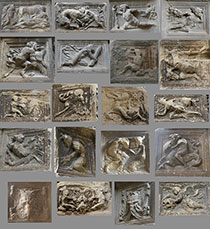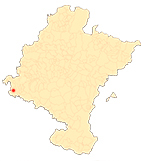Front façade of the parish church of Santa María de Viana
Stories of Hercules
On the base of the cover, distributed in panels and netting, there are 31 reliefs depicting themes related to the works of Hercules, alternating with animals and fantastic beings and grotesques. Among the themes related to Hercules we find some of his best known works, such as his fights against the lion of Nemea, the hydra of Lerna, the boar of Erimanto, the birds of Lake Stymphalus or the giant Geryon, as well as others not integrated in his works or forming a secondary part of them, such as his fights against the lion of Cytheron, the giant Cacus or the river god Achelous, besides Hercules as an allegory of the fortress. Some of these scenes can be related to their symbolic meaning as allegories of the fight against some of the most frequent sins, such as pride, lust or greed. This interpretation of classical themes sifted from a Christian point of view will be one of the constants of the Renaissance, and the figure of Hercules, the classical hero par excellence, is recognized as a prefiguration of Christ, as a virtuous hero who fights against evil. Therefore, the presence of these themes on the cover of the church should be interpreted from a reading of the victory of virtue over vice, of good over evil, incarnated by the figure of Christ, the new Hercules, who with his death redeems man. And the stories of Hercules alternate with representations of grotesques, angels, children, buckthorns, tarjas, animals and fantastic beings, etc., among which are themes and sea monsters, which during the 16th century had a symbolism of immortality. These themes will serve as an example to the faithful of the attitude to follow, and for this reason they are placed on the base of the cover, so that they are easily visible, since they symbolize the hope of life after death, embodied in the belief in the Redemption of men achieved thanks to the death of Christ.
-
ESTEBAN LORENTE, J.F., "El arco de ingreso de la colegiata de Santa María de Viana. Horóscopo de Cristo", Berceo, 130, 1996, pp. 177-178.
-
ESTEBAN LORENTE, J.F., "Los dioses paganos en las iglesias españolas del siglo XVI", bulletin del Museo e high school Camón Aznar, LXXXII, Zaragoza, high school Camón Aznar, 2000, pp. 157-190.
-
FERNÁNDEZ GRACIA, R., (coord.), ECHEVERRIA GOÑI, P.L., and GARCÍA GAINZA, M. C., El arte del Renacimiento en Navarra, Pamplona, Gobierno de Navarra, 2005, pp. 111-114.
-
GARCÍA GAINZA, M. C., HEREDIA MORENO, M. C., RIVAS CARMONA, J. and ORBE SIVATTE, M., Catalog Monumental de Navarra. V. II**. Merindad de Estella, Pamplona, 1980, pp. 559-564.
-
GONZÁLEZ DE ZÁRATE, J. M., "Aproximaciones a la lectura iconográfica del programa mitológico en la portada de Santa María de Viana", Primer congress General de Historia de Navarra, anejo 11, Pamplona, Príncipe de Viana, 1988, pp. 179-196.
-
LABEAGA MENDIOLA, J.C., Viana monumental y artística, Pamplona, Príncipe de Viana, 1984, pp. 229-236.












